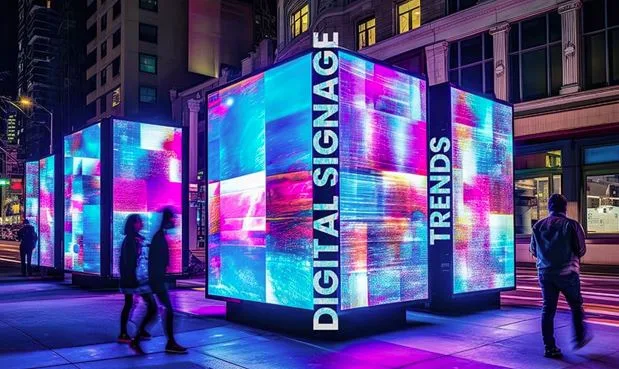Digital Signage Trends 2025: How Visitor Management and Smart Displays Redefine Experiences
The world of digital communication doesn’t stand still. Screens have long since moved beyond being passive billboards flashing static ads. They now interact, adapt, and predict. In the coming year, one phrase keeps echoing through conference halls and boardrooms: digital signage trends 2025. But here’s the twist—this isn’t just about shiny new displays or futuristic gadgets. It’s about how signage intertwines with visitor management, shaping how people experience spaces, from airports and museums to hospitals and corporate campuses.
From Static Screens to Dynamic Experiences
A decade ago, digital signage was a glorified slideshow. Content loops ran on repeat, hoping to catch someone’s eye. Fast-forward to 2025, and we’re witnessing a revolution in engagement. Displays are no longer mere surfaces for broadcasting. They are real-time communication hubs. Sensors track movement, cameras recognize returning guests, and AI tailors content in milliseconds.
For visitor management, this means an airport screen doesn’t just tell you where your gate is—it guides you based on your digital boarding pass, language preference, and current foot traffic. A museum screen doesn’t simply show an exhibit description—it reshapes its narrative if it notices a group of schoolchildren versus a couple on a quiet weekend tour.
AI-Driven Personalization in Public Spaces
The heart of the shift lies in personalization. AI transforms signage into a conversation rather than a lecture. Imagine entering a corporate office: instead of walking to a reception desk, a display greets you by name after scanning your QR code, directs you to your meeting room, and pushes a visitor badge from the integrated kiosk system.
In visitor management, this bridges a crucial gap—security and hospitality. Guests feel recognized without the coldness of checkpoints, while hosts benefit from automated ID verification and streamlined access control. It’s personalization, but with accountability woven in.
Micro-Targeting Content for Micro-Moments
Another piece of the 2025 puzzle is timing. No one wants to see a general corporate promo when they’re rushing to a meeting. Digital signage now reads context: morning hours might show welcome messages and coffee discounts, while midday transitions into wayfinding or safety updates. By evening, the same screens may transform into cultural guides for guests staying overnight in corporate housing or nearby hotels.
Visitor Flow and Crowd Intelligence
The intersection of signage and visitor management shines brightest when it comes to movement. Traditional visitor flow studies required endless observation and manual data crunching. Now, signage networks themselves become data collectors.
In a large convention center, digital signage directs attendees dynamically, alleviating bottlenecks by suggesting alternative routes. In a hospital, it prioritizes emergency pathways, rerouting non-critical visitors when ambulances are inbound. This isn’t simply smart; it’s humane—technology ensuring safety while keeping experiences seamless.
Predictive Analytics in Visitor Journeys
Predictive algorithms forecast congestion before it happens. If sensors detect an unusually high influx of visitors at a stadium gate, digital signage instantly communicates alternative entry points. Visitor management systems sync with ticketing data, alerting security while updating fans’ smartphones and public screens simultaneously. It’s not control for control’s sake—it’s orchestration of thousands of individual journeys into a coherent flow.
Green Signage and Sustainable Engagement
Digital signage has often been criticized for energy consumption, but the tide is turning. By 2025, eco-friendly initiatives are taking center stage. Solar-powered kiosks, e-ink displays for low-traffic zones, and intelligent dimming systems reduce waste.
For visitor management, sustainability isn’t just environmental—it’s reputational. A company that greets guests through energy-efficient digital touchpoints communicates a brand value of responsibility. In industries like healthcare or government, this message extends beyond optics; it reinforces trust in institutions tasked with safeguarding society.
Hybrid Realities: AR and Mixed Media
The line between screen and reality is blurring. Augmented reality overlays now complement physical signage. Picture entering a university campus: a display points you to your destination, but your phone unlocks an AR guide showing real-time walking directions, professor bios, or live cafeteria menus.
For visitor management, AR elevates onboarding. A new employee doesn’t just sign in; they follow a holographic path through their new office, guided step by step until they reach their desk. The combination of physical digital signage and AR bridges the tangible and the virtual in ways that plain paper maps never could.
Security Beyond the Badge
Visitor management is inseparable from security. As digital signage integrates deeper with access systems, we’re seeing a move toward invisible authentication. Biometric recognition at entry points doesn’t just unlock doors—it updates internal signage to reflect the visitor’s clearance level.
A guest at a financial institution might only see navigational signage to meeting rooms, while employees have access to real-time corporate dashboards. Signage becomes the visual layer of access control, democratizing information while protecting sensitive zones.
The Role of Storytelling in Brand Presence
While the technological backbone is dazzling, the true power of digital signage lies in storytelling. Every visitor interaction is an opportunity to shape perception. A screen in a lobby can broadcast corporate news, but in 2025 it does more: it tells stories of community involvement, showcases client success, or highlights employee achievements.
Visitor management systems integrate by ensuring the right story is shown to the right person. A potential investor walking in sees strategic milestones; a job candidate sees career opportunities; a supplier sees collaborative innovations. Each journey is tuned, and the signage becomes the company’s narrator.
Measuring Impact in Real Time
The biggest challenge of digital signage has always been ROI. How do you prove that a screen in the lobby adds measurable value? The answer in 2025 is analytics. Screens are no longer blind transmitters—they track impressions, dwell time, interaction rates, and even emotional responses.




